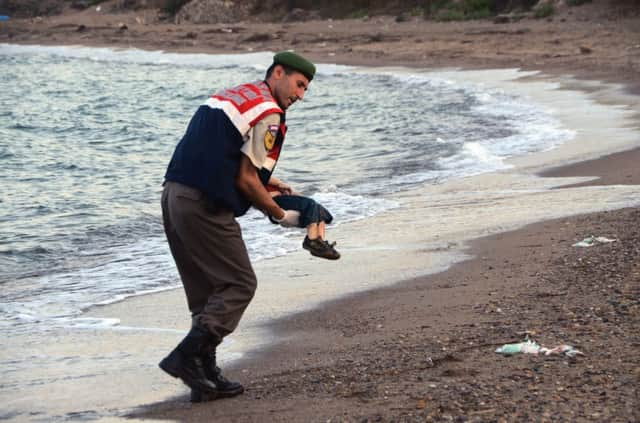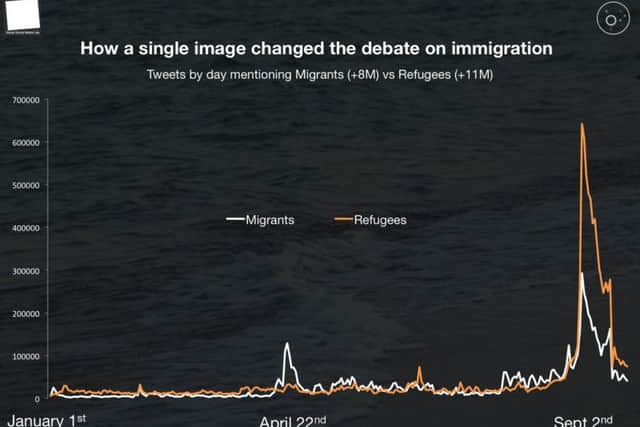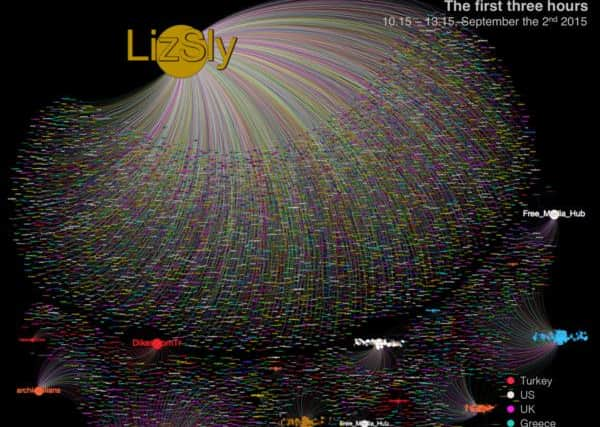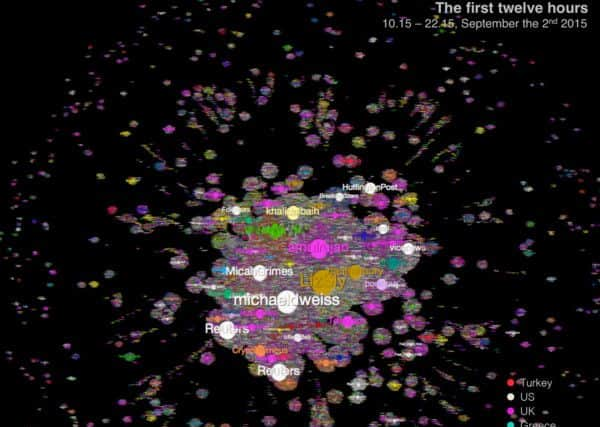Aylan Kurdi: How one photograph changed the debate on immigration
This article contains affiliate links. We may earn a small commission on items purchased through this article, but that does not affect our editorial judgement.


Now researchers from the University of Sheffield have shown how social media, and the image of Aylan Kurdi, changed the debate on immigration, by analysing three million social media posts.
Experts from the university’s Visual Social Media Lab wanted to unravel how a deeply personal tragedy, born out of the civil conflict in Syria, became one of the most iconic image-led news stories of our time.
Advertisement
Hide AdAdvertisement
Hide AdThey examined how the pictures of Aylan, and his body being removed from the beach by a police officer, galvanised the global conscience, and how sites such as Twitter and Facebook, and searching on Google, can suddenly change the very language of the debate on immigration.
In addition to examining how the photograph went viral, reaching almost 20 millions people around the world in 12 hours, Google’s News Lab data journalism team in California analysed millions of searches around the death of Aylan to show how, when and where the world started searching and what they were looking for.
The report shows how “a handful of tweets” by journalists grew into 53,000 tweets per hour as interest in the story “went viral”.
Director of the Visual Social Media Lab, Dr Farida Vis, said: “As soon as we saw the image and the response we felt that something extraordinary was happening. Given our research expertise and that of fellow researchers who joined this effort, we felt we should do something to better understand this phenomenon. Somehow this image of this child made the refugee crisis really visible. We wanted to understand why this was the case.
Advertisement
Hide AdAdvertisement
Hide Ad“We also wanted to better understand how these images had spread so quickly between the local, national and global media but also between social media and the mainstream media. We wanted to measure the impact these images have had on the wider public debate about the status of migrants and refugees. Our analysis clearly shows that this story not only engaged a global audience, but that it changed the way social media users talked about the issue of immigration.”


Dr Vis and the team decided not to use the image in their final report out of respect to the child’s father. They also remarked on the fact that the child’s name is actually Alan, not Aylan, but decided to use Aylan as it is the name the image was “globally circulated and identified with”.
Using data provided and analysed by the Lab’s partner, Pulsar, Dr Vis and her team were able to identify a sudden and unexpected shift in the way people were talking about the issue of migration on social media.
Dr Francesco D’Orazio, co-founder of the Visual Social Media Lab, VP Product & Research at Pulsar and co-author of the report, said: “For most of 2015, the use of the words migrants and refugees was head to head in public conversation, accounting for pretty much the same volume over nine months – 5.2 million tweets versus 5.3 million tweets. From September 2 onward this radically flipped. The numbers swing dramatically towards a clear focus on refugees – 2.9 million tweets and 6.5 million tweets.”
Advertisement
Hide AdAdvertisement
Hide AdHowever, this legacy may have been affected following terror attacks in Paris in November, when it was reported that a passport belonging to a Syrian refugee was found at the scene.


Dr Vis said: “This prompted many UK newspapers to run a headline that swayed the rhetoric once again towards ‘defence of the borders’. Indeed, it looks more likely that the softening of attitudes to refugees which the image of Aylan Kurdi gave rise to will be to a greater or lesser extent undone.”
The study tracks the key moments in the evolution of the story from a few hundred tweets, with limited geographical spread, to its expansion into wider Middle Eastern audiences. It is at this point that the story goes viral and global.
The pictures had been shared less than 500 times before Washington Post Beirut Bureau Chief, Liz Sly shared it. That tweet was retweeted 7,421 times, becoming “the most viral post in the dataset”, the report said.
Advertisement
Hide AdAdvertisement
Hide AdDr D’Orazio wrote: “Liz Sly changes the scale of the diffusion, generating in the first 30 minutes of her post the same amount of tweets that had been generated in the previous two hours.”


The journey of these images also shows the key role Twitter played in spreading the story.
Dr D’Orazio added: “Twitter’s ability to act as a catalyst has connected emerging stories and relevant people, helping to develop and connect those audiences on a global scale and make a story go mainstream before the international press has even started to officially cover it. But we shouldn’t forget that it was the journalists on the ground that broke the story on Twitter and through the social platform put it in front of the right audience, facilitating a very effective andoptimized diffusion dynamic.”
The report goes on to discuss how the image changed the news agenda.
Advertisement
Hide AdAdvertisement
Hide AdDr Claire Wardle, Research Director at the Tow Center for Digital Journalism at Columbia University and one of the report’s authors, said: “2015 was the year the Syrian refugee crisis hit the European consciousness, but it’s easy to forget that this was not the case before the Aylan Kurdi image.
“In April, over 700 refugees and migrants lost their lives when their boat capsized off Lampedusa. After one day of coverage, the story disappeared, despite the tragic loss of life. The photo of Aylan Kurdi galvanised the public in a way that hours of broadcasts and thousands of column inches wasn’t able to do. It has created a frame through which subsequent coverage has been positioned and compared.
“This research provides concrete evidence of the ways in which this image framed the biggest story of 2015, the flight of Syrian refugees to Europe.”